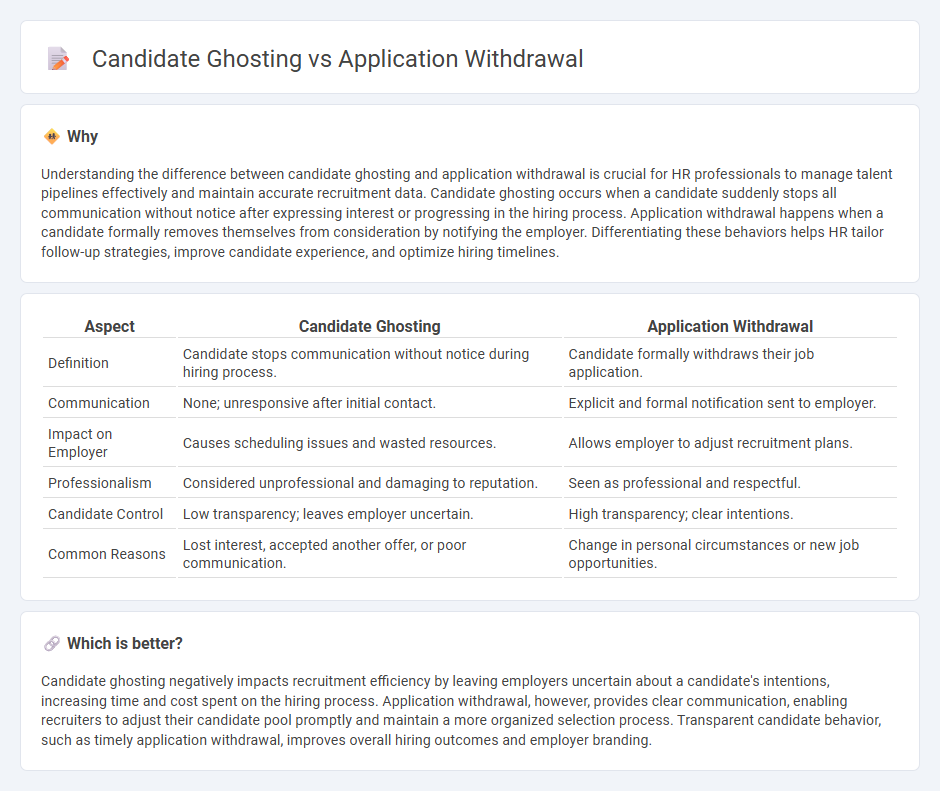
Candidate ghosting occurs when job seekers suddenly stop responding to employers during recruitment, while application withdrawal involves candidates formally removing their job application from consideration. Understanding the causes and impacts of both behaviors is essential for optimizing talent acquisition strategies and improving candidate experience. Discover more about managing candidate ghosting and application withdrawals effectively.
Why it is important
Understanding the difference between candidate ghosting and application withdrawal is crucial for HR professionals to manage talent pipelines effectively and maintain accurate recruitment data. Candidate ghosting occurs when a candidate suddenly stops all communication without notice after expressing interest or progressing in the hiring process. Application withdrawal happens when a candidate formally removes themselves from consideration by notifying the employer. Differentiating these behaviors helps HR tailor follow-up strategies, improve candidate experience, and optimize hiring timelines.
Comparison Table
| Aspect | Candidate Ghosting | Application Withdrawal |
|---|---|---|
| Definition | Candidate stops communication without notice during hiring process. | Candidate formally withdraws their job application. |
| Communication | None; unresponsive after initial contact. | Explicit and formal notification sent to employer. |
| Impact on Employer | Causes scheduling issues and wasted resources. | Allows employer to adjust recruitment plans. |
| Professionalism | Considered unprofessional and damaging to reputation. | Seen as professional and respectful. |
| Candidate Control | Low transparency; leaves employer uncertain. | High transparency; clear intentions. |
| Common Reasons | Lost interest, accepted another offer, or poor communication. | Change in personal circumstances or new job opportunities. |
Which is better?
Candidate ghosting negatively impacts recruitment efficiency by leaving employers uncertain about a candidate's intentions, increasing time and cost spent on the hiring process. Application withdrawal, however, provides clear communication, enabling recruiters to adjust their candidate pool promptly and maintain a more organized selection process. Transparent candidate behavior, such as timely application withdrawal, improves overall hiring outcomes and employer branding.
Connection
Candidate ghosting and application withdrawal both disrupt the recruitment process by creating unpredictability in candidate engagement and timeline management. Ghosting occurs when candidates suddenly cease communication after interviews, while application withdrawal happens when candidates officially retract their applications before the hiring decision. These behaviors challenge HR professionals to improve candidate experience and implement proactive communication strategies to maintain a reliable talent pipeline.
Key Terms
Communication
Effective communication plays a crucial role in distinguishing between application withdrawal and candidate ghosting, where clear, timely responses confirm a candidate's decision and respect the recruiter's time. Application withdrawal involves a formal notification from the candidate, signaling respect and professionalism, while candidate ghosting leaves recruiters uncertain and disrupts the hiring process. Explore strategies to enhance communication and minimize candidate ghosting for a smoother recruitment experience.
Candidate experience
Application withdrawal occurs when candidates formally retract their job applications, reflecting a conscious decision to disengage from the recruitment process, while candidate ghosting happens when candidates abruptly cease all communication without notice, causing uncertainty and potential disruption for recruiters. Both phenomena significantly impact the candidate experience by highlighting the importance of transparent communication and respect for mutual time investment during hiring. Explore strategies to enhance candidate engagement and improve hiring outcomes by reducing withdrawal and ghosting occurrences.
Recruitment process
Application withdrawal occurs when a candidate formally removes themselves from the recruitment process, providing clarity for hiring teams to adjust their strategies accordingly. Candidate ghosting, characterized by sudden and unexplained non-responsiveness, disrupts the recruitment timeline and can lead to increased costs and resource allocation challenges. Explore effective methods to mitigate these issues and optimize your recruitment outcomes.
Source and External Links
How To Withdraw an Application (With Tips and Examples) - You can withdraw an application by rescinding it online if no interview invitation was received, informing your recruiter if applicable, or sending an email to the hiring manager to professionally notify them of your decision and thank them for their time.
Request for Withdrawal of Application (SSA-521) - This form is used to withdraw an application for Social Security benefits, which cancels the decision made on the application and requires repayment of any benefits received; withdrawal may affect rights and future applications.
How to Withdraw an Application Professionally? (Expert Tips) - Professional withdrawal involves sending a simple, direct email or letter thanking the employer, explaining your reason if comfortable, and doing so promptly to maintain good relationships; common reasons include accepting another offer, changes in personal circumstances, or concerns raised during interviews.
 dowidth.com
dowidth.com